By Nicholas Asheshov ✐
Special to Peruvian Times ☄
As Francisco, Gonzalo, Francisco Martin, and Juan Pizarro neared Cuzco in 1533, they were met a day’s march from the Inca capital by a deputation presenting to them the 17-year-old Manco Inca.
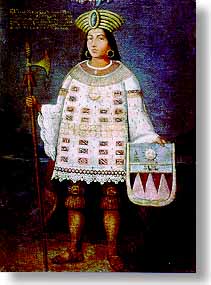 The Pizarros had just garroted Atahualpa, Manco’s half-brother, in Cajamarca after reaching Peru for the first time a few months earlier. They were happy to set up young Manco as a front man.
The Pizarros had just garroted Atahualpa, Manco’s half-brother, in Cajamarca after reaching Peru for the first time a few months earlier. They were happy to set up young Manco as a front man.
It probably wouldn’t have worked anyway but a new tragedy unfolded that has colored Peru ever since. Gonzalo Pizarro, a tough, tall, ferociously brave bully, conceived a passion for Manco’s young wife and half-sister, the beautiful, clever, loyal Kura Ocllo.
Gonzalo persisted. The Inca court gave him all the girls he could want. They even gave him another pretty half-sister, Inguill, and dolled her up to look like Kura. But after a few nights Gonzalo realized the deception and kicked Inguill out.
Gonzalo then simply grabbed and raped Kura and kept her. Manco, furious and desperate, left Cuzco. The rape by Gonzalo of Kura Ocllo set off a 40-year rebellion that blocked any possibility of a meeting of the minds between Conquistadors and Incas.
Kura escaped back to Manco and they both retreated to the mountain-jungle fastness of Vilcabamba, beyond Machu Picchu. From here they waged a partly-successful war against the Spaniards.
In one incident it was Kura Ocllo herself, now 20, who spotted a detachment of Spaniards creeping up a steep path to Oncoy, above the Apurimac, to capture Manco. She organized the womenfolk to impersonate Inca troops to frighten the Spaniards while Manco himself led the charge on the Spaniards, killing all 30 of them, a tremendous victory that ought to be celebrated by an annual national holiday.
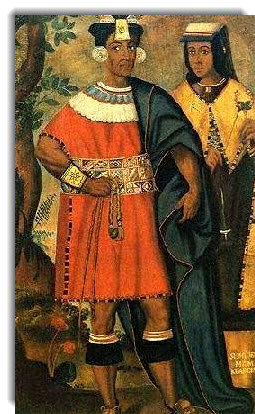 Gonzalo himself then led a military expedition into the Vilcabamba. With him went two of Manco’s half-brothers, full brothers to Kura Ocllo. These went ahead to try to negotiate with Manco who, however, had them immediately beheaded —in front of Kura Ocllo. As Gonzalo and his men closed in, Manco escaped, but alone. The horrified Kura Ocllo, paralyzed with shock, refused to desert the bodies of her brothers and was captured.
Gonzalo himself then led a military expedition into the Vilcabamba. With him went two of Manco’s half-brothers, full brothers to Kura Ocllo. These went ahead to try to negotiate with Manco who, however, had them immediately beheaded —in front of Kura Ocllo. As Gonzalo and his men closed in, Manco escaped, but alone. The horrified Kura Ocllo, paralyzed with shock, refused to desert the bodies of her brothers and was captured.
Gonzalo threw Kura to his men. On the way back to Ollantaytambo, she tried to protect herself by covering herself in her own excrement.
In the plaza of Ollantaytambo, where today hundreds of tourists park their buses every day, Francisco and Gonzalo Pizarro ordered her stripped naked, tied to a stake and whipped while Cañari mercenaries stoned her and shot arrows into her.
She refused to cry out, the chroniclers report, until just before dying, she shouted out, “You take your anger out on a woman?…. Hurry up and finish me off, so that you can satisfy all of your desires!”
Manco, like his wife-sister, was clearly a noble, brave, devastatingly young leader. He was assassinated in Vilcabamba a few years later by the same renegade Spaniards who earlier had killed Francisco Pizarro himself down in Lima.
Gonzalo rebelled against the Crown, killed the Viceroy and 300 royalist Spaniards and was later executed in Cuzco by a new Virrey.
Manco and Kura Ocllo, youthful, dashing, are the stunning heroes in one of the epic moments of world history.
Here is Othello and Romeo & Juliet all in one, a crueler, nobler Helen of Troy-Paris-Achilles.
But how many Peruvian children, or their parents, know this story? Two of my children did their early-days schooling within a couple of miles of the scene of Kura Ocllo’s outrageous death. But I’ve asked them, and other Urubamba kids, and they know her not.
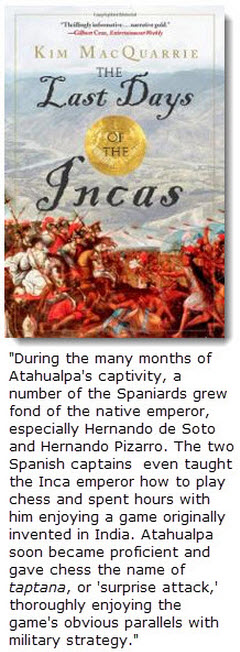 Nor did I, of course. I have extracted and summarized the Kura Occlo story from Kim MacQuarrie’s excellent The Last Days of the Incas, being published in Spanish in Lima (and in a separate English edition), and Kura Occlo and Manco are just two of a great cast of characters in a gigantic confrontation, the collision of two of the great traditions of humankind.
Nor did I, of course. I have extracted and summarized the Kura Occlo story from Kim MacQuarrie’s excellent The Last Days of the Incas, being published in Spanish in Lima (and in a separate English edition), and Kura Occlo and Manco are just two of a great cast of characters in a gigantic confrontation, the collision of two of the great traditions of humankind.
In France, Joan of Arc, burned at the stake by the English in 1431, is a much-loved heroine, a registered saint and, indeed, us English treat her memory with equal affection. The English are also proud of Boadicea, the Celtic queen who was, with her daughters, publicly tortured, gang-raped and killed by the Romans two millennia ago. Kura Ocllo deserves, surely, to be remembered with similar pride by Peruvian schoolchildren. Manco, likewise.
MacQuarrie’s sources for the Kura Ocllo story are the account dictated by Manco’s son, Titu Cusi, the last-but-one Inca, to Cristobal de Molina, and a letter by a Spaniard explaining to the King of Spain how Gonzalo stole Manco’s wife.
MacQuarrie’s The Last Days of the Incas tells the stupendous story of the Conquista better than anyone so far. It is deliberately dramatic—”blood dripped from Pizarro’s sword” etc. But it is also carefully researched and runs parallel to John Hemming’s definitive classic, The Conquest of the Incas, which appeared in 1970 and updated and translated into Spanish in 1995, a gripping must-read.
But Kim MacQuarrie’s Last Days brings the cruelty, the civilizing savagery, the wealth that was to transform the economy of Europe, and above all, the characters to immediate life.
The five Pizarro brothers, unbelievably tough and courageous, impossibly wealthy, low-born and ambitious. The backdrop was a society, the last, sadly, of a score of great cultures produced here over many millennia, which functioned much better than any contemporary in Europe, and incomparably better than any that has struggled since to succeed in Peru or anywhere else in South America.
Perhaps MacQuarrie’s Last Days will inspire teachers in schools all over Peru, high and low, to take a new, proud look at their own world-class predecessors.
_______________________________
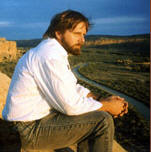 ABOUT THE AUTHOR: Kim MacQuarrie, an anthropologist and documentary filmmaker, spent five years in Peru, during which time he was a staff writer on The Lima Times, published by Peruvian Times, and spent some time living with a recently contacted tribe in the Amazon rainforest only 100 miles from Machu Picchu. He has written three earlier books on Peru. He has won multiple Emmy Awards for his documentary films, and recently produced and directed a 10-part documentary series for the Discovery Channel, The Tattoo Hunter, which explores native ornamentation around the world.
ABOUT THE AUTHOR: Kim MacQuarrie, an anthropologist and documentary filmmaker, spent five years in Peru, during which time he was a staff writer on The Lima Times, published by Peruvian Times, and spent some time living with a recently contacted tribe in the Amazon rainforest only 100 miles from Machu Picchu. He has written three earlier books on Peru. He has won multiple Emmy Awards for his documentary films, and recently produced and directed a 10-part documentary series for the Discovery Channel, The Tattoo Hunter, which explores native ornamentation around the world.
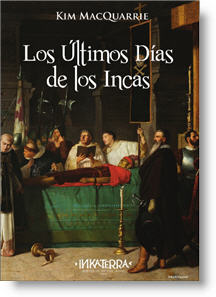 ABOUT THE BOOK: The first edition in Spanish, and the new edition in English for distribution in Peru, have been published by Inkaterra, the award-winning luxury hotel and ecolodge group recognized for its environmental stewardship. Inkaterra was founded in 1975 by Joe Koechlin, a pioneer in sustainable tourism, who is president of the Peru Hotels association and a director of the National Chamber of Tourism, Canatur. The book is available in Spanish at leading bookstores, and the English edition will be available in Lima in June.
ABOUT THE BOOK: The first edition in Spanish, and the new edition in English for distribution in Peru, have been published by Inkaterra, the award-winning luxury hotel and ecolodge group recognized for its environmental stewardship. Inkaterra was founded in 1975 by Joe Koechlin, a pioneer in sustainable tourism, who is president of the Peru Hotels association and a director of the National Chamber of Tourism, Canatur. The book is available in Spanish at leading bookstores, and the English edition will be available in Lima in June.
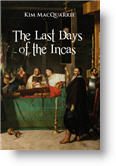 FX, the cable channel owned by Fox, has taken on a project this year to produce a 10-12 part series based on the book.
FX, the cable channel owned by Fox, has taken on a project this year to produce a 10-12 part series based on the book.
Nick Asheshov. a veteran journalist, noted explorer and entrepreneur, was editor of the Peruvian Times from 1969 to 1990.






Thank you for a very interesting summary of some important events in history of Peru. I look forward to reading the suggested book. However, I am having a difficult time understanding the second last paragraph. After reading it several times I think you are saying that the indigenous society at the time of the Spanish conquest was better than any in Europe or South America at that time and much better than any in Peru since that time. If this is what you are attempting to say, I would have to say that it may have been a “great” society historically, but it is a stretch to claim that it was a “better” society. I think we do not know enough about it to make that claim.